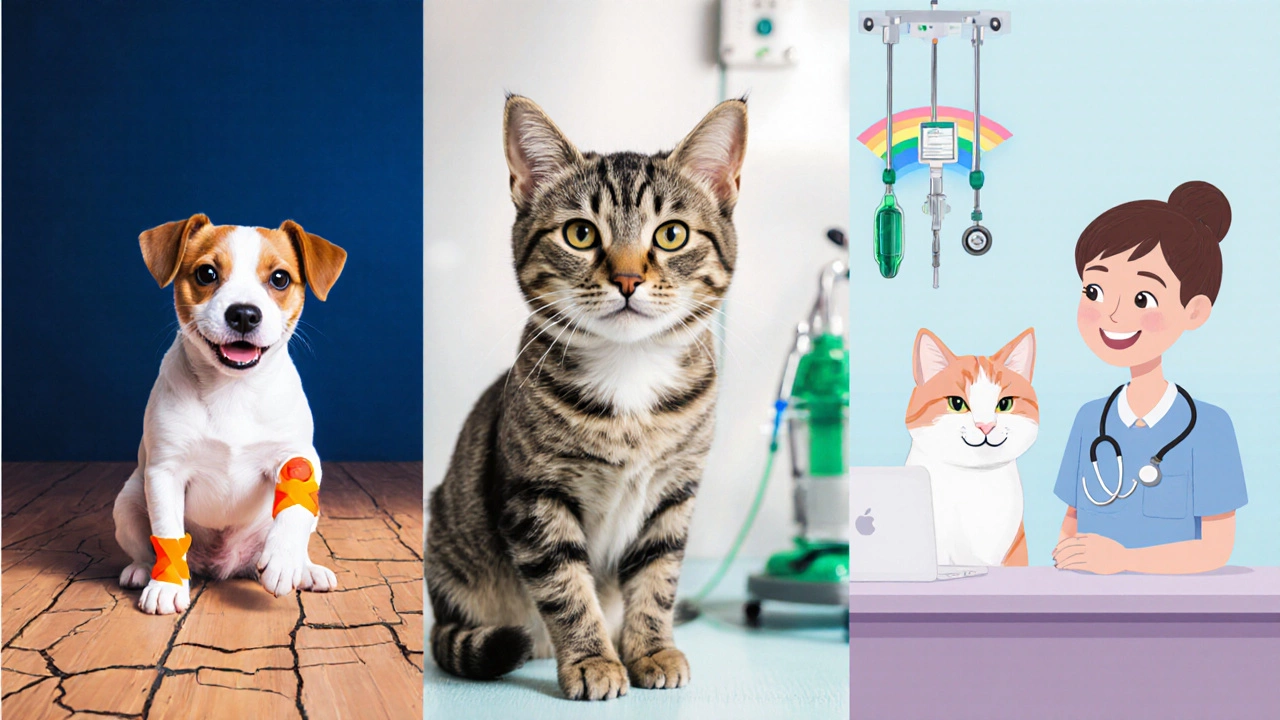Pet Insurance Type Selector
Accident-Only
Covers injuries only
$10-$20/month
- Lowest cost
- Simple to understand
- Best for young pets
Illness-Only
Covers diseases and chronic conditions
$15-$35/month
- Protects against expensive treatments
- Good for breeds with hereditary issues
- Middle-tier cost
Comprehensive
Covers both accidents and illnesses
$25-$50/month
- One-stop solution
- Fewer claim hassles
- Often includes wellness care
Key Takeaways
- Pet insurance generally falls into three categories: accident‑only, illness‑only, and comprehensive.
- Accident‑only policies are cheap but only cover injuries; illness‑only policies cover diseases but not injuries.
- Comprehensive plans bundle both and often let you add routine‑care coverage.
- Choosing the right type depends on your pet’s age, breed, health history, and your budget.
- Read the fine print for exclusions, deductibles, and claim limits before you sign.
What is Pet Insurance?
Think of pet insurance as a safety net that helps you pay for unexpected veterinary bills. Instead of paying a big bill out‑of‑pocket, you submit a claim and the insurer reimburses a percentage of the approved cost. Policies differ in what they cover, how much you pay each month (the premium), and what you have to pay first (the deductible). Understanding the three main pet insurance types is the first step to picking a plan that won’t break the bank.

The Three Core Types
Accident‑Only Insurance
This is the most basic option. It kicks in when your dog or cat suffers a sudden injury-think broken bones, cuts, or ingestion of a foreign object. Because the risk pool is narrow, premiums are usually the lowest. However, if your pet later develops an illness, you’ll need a separate policy or pay fully out of pocket.
Who benefits? Owners of young, generally healthy animals who want inexpensive coverage for mishaps.
Illness‑Only Insurance
Illness‑only plans cover diseases, infections, and chronic conditions such as diabetes, arthritis, or cancer. Injuries are excluded, so you’ll still need an accident rider if you want full protection. Premiums sit in the middle range-higher than accident‑only but lower than all‑in‑one coverage.
Who benefits? Pet parents with breeds prone to hereditary diseases or older pets with a history of health issues.
Comprehensive Insurance
Also called “full‑coverage” or “all‑risk” policies, these combine accident and illness protection in a single contract. Many providers let you tack on a wellness or routine‑care rider for vaccinations, flea‑preventatives, and annual exams. Premiums are the highest, but you pay fewer administrative fees and avoid gaps in coverage.
Who benefits? Owners who prefer a one‑stop solution and are comfortable with a steadier monthly cost.
How to Choose the Right Type for Your Pet
- Assess your pet’s risk profile. Young, active dogs often face injuries, while senior cats may develop chronic illnesses.
- Set a budget ceiling for monthly premiums. Remember to factor in the deductible and reimbursement percentage (usually 70‑90%).
- Read the exclusions list. Common exclusions include pre‑existing conditions, hereditary disorders, and elective procedures.
- Consider adding a wellness rider if you expect regular check‑ups.
- Ask your vet for an estimate of expected yearly costs. Compare that number to the total out‑of‑pocket you’d pay after deductibles.
Typical Costs and What Affects Premiums
| Type | Coverage | Typical Premium (USD/month) | Ideal For | Pros | Cons |
|---|---|---|---|---|---|
| Accident‑Only | Injuries only | $10‑$20 | Young, low‑risk pets | Low cost, simple to understand | No illness coverage, may need separate policy |
| Illness‑Only | Diseases and chronic conditions | $15‑$35 | Breeds with known health issues | Protects against expensive treatments | Excludes accidents, higher deductible |
| Comprehensive | Both accidents & illnesses (plus optional wellness) | $25‑$50 | Owners who want full peace of mind | One‑stop coverage, fewer claim hassles | Highest monthly cost, may include more exclusions |
Premiums vary by deductible, breed, age, and location. A higher deductible lowers the monthly payment but raises the amount you pay before the insurer reimburses you.

Common Pitfalls to Avoid
- Signing up without checking the exclusions list. Some policies don’t cover hereditary disorders that certain breeds are prone to.
- Assuming the insurer will pay 100% of the bill. Most plans reimburse 70‑90% after the deductible.
- Waiting too long to file a claim. Most companies require a claim within 30 days of treatment.
- Neglecting to update the policy when your pet’s health changes. Adding a new condition later may be impossible.
Quick Checklist Before Buying
- Identify which of the three types aligns with your pet’s primary risk.
- Calculate expected yearly vet costs and compare them to the total annual premium plus deductible.
- Read the fine print for pre‑existing condition clauses.
- Confirm the reimbursement percentage and any annual payout caps.
- Check if the insurer offers a direct‑pay option to the vet (some do, which speeds up the process).
Frequently Asked Questions
Can I switch from accident‑only to comprehensive later?
Yes, most insurers allow you to upgrade at any time, but you may need to wait a 30‑day waiting period before new coverage kicks in. Prices may also increase based on your pet’s age and health changes.
What is a waiting period?
A waiting period is the time after you purchase a policy during which you cannot submit claims for certain conditions. Accident coverage might be effective after 48 hours, while illness coverage can take up to 14 days.
Do I need a separate wellness plan?
If you want routine care (vaccines, dental cleanings, flea meds) covered, add a wellness rider. Some comprehensive policies bundle it for an extra $5‑$10 per month, which can be cheaper than paying out‑of‑pocket for each visit.
How does the claim process work?
After treatment, request an itemized invoice from your vet, fill out the insurer’s claim form (often online), attach the invoice, and submit. Reimbursements usually arrive within 7‑10 business days.
Are there age limits for enrolling my pet?
Most companies accept dogs up to 12 years and cats up to 14 years, though premiums rise sharply as pets age. Some insurers cap enrollment at 8 years for dogs.
